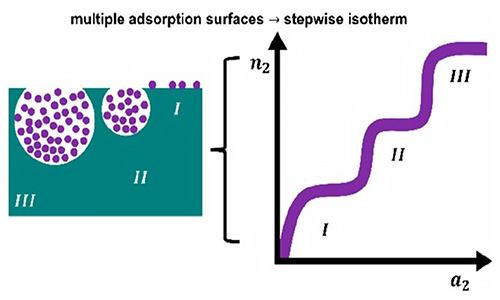MChem Student Solves Adsorption Problem
Olivia Dalby (MChem, 2021) has had her MChem project work, providing new insights into adsorption on solid surfaces, published in the journal Langmuir as the lead author.
The adsorption of chemical species on surfaces is important across a range of disciplines, such as understanding the effect of humidity on the moisture content of food or the water content of cement paste. Adsorption isotherms are routinely measured when characterising battery and porous materials. However, explaining and modelling such isotherms based on the underlying molecular interactions is a very challenging task, especially when the surface is heterogeneous, meaning that adsorption can take place in a stepwise manner.

Figure: Stepwise adsorption on a heterogeneous solid surface.
Olivia carried out a theoretical study, supervised by Dr Seishi Shimizu focusing on these challenging adsorption isotherms. Her task was made even more difficult by the pre-existence of more than 80 different isotherm models, each having different scopes and premises.
Olivia focused on particularly challenging stepwise and multiple-stepwise isotherms. These are usually observed in heterogeneous surfaces that contain pores of both microscopic and mesoscopic sizes. Unlike previous approaches that start from an assumed adsorption mechanism, Olivia helped to establish a novel, unified approach, that can model all types of isotherms, based directly on the fundamental principles of statistical thermodynamics.
The paper comes with an interactive web-based app written by Professor Steven Abbott working at TCNF Ltd, Ipswich. In this way, measured isotherm data can be directly analyzed by the new theory.
This work is the culmination of a long-time collaboration between Dr Shimizu and Professor Nobuyuki Matubayasi from Osaka University in Japan. The authors hope that the new unified theory will allow the simple modelling of all adsorption isotherms, rather than researchers having to select the appropriate model from many different possibilities.

Olivia said, “I am excited to see my MChem work published in Langmuir. I really enjoyed working on this with my supervisor, Dr Seishi Shimizu, and the coauthors, even with the challenges of online meetings in lockdown! I am proud of the work we achieved, and look forward to see how this paper may help future adsorption isotherm studies.”
Olivia’s work is published in Langmuir.